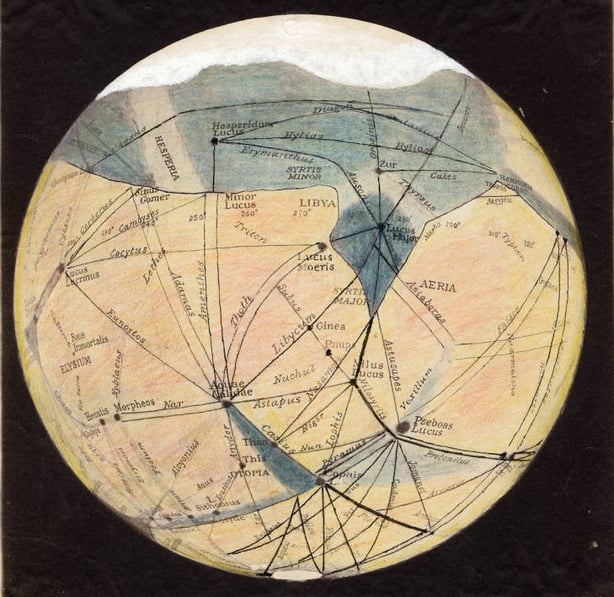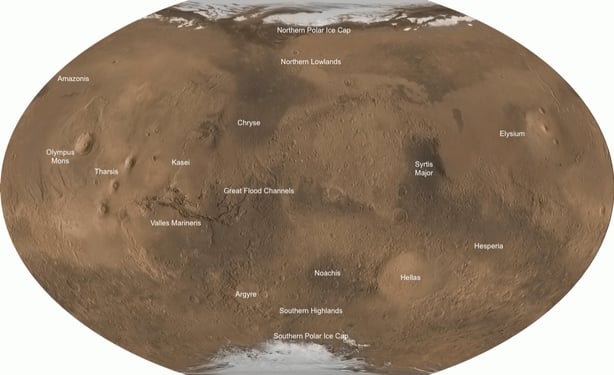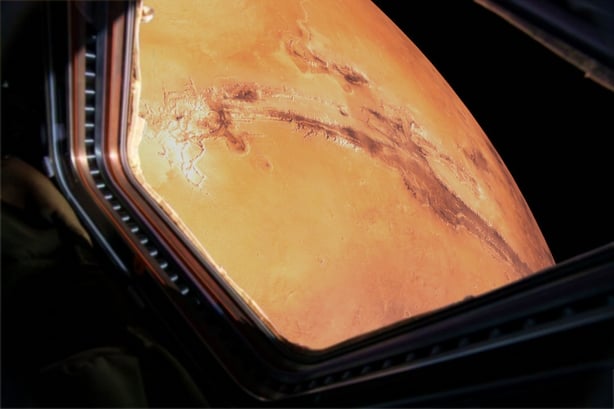Analysis: Mars holds sway over other destinations in space so why are we so drawn to the planet?
Space probes traversing the Solar System, an International Space Station (ISS) and the commercialisation of Earth Orbit all point to "Space" being a now permanent endeavour. But whether via robotic rovers or the perennial aspiration to send people there, Mars holds sway over other destinations in space. Why are we drawn to Mars - and does it offer what experts and technocrat billionaires proport?
Two great domains underpin science: the origin and nature of the Universe, and of life. No one has ever known life's origin. We're confident there's a planetary dimension to it, suggesting a universal context for life too, but with evidence of our origins gone and detecting life around other stars prohibitive, answers have been sparse. It turns out that an opportunity to explore the origin of life exists: on Mars!
We need your consent to load this rte-player contentWe use rte-player to manage extra content that can set cookies on your device and collect data about your activity. Please review their details and accept them to load the content.Manage Preferences
From RTÉ Radio 1's Drivetime, is there life on Mars?
A 'chequered history'
We have a chequered history with Mars. In 1609, Johannes Kepler used Mars' orbit to determine that it is orbiting the Sun and not Earth. Over two hundred years astronomers discovered Mars' 24-hour day, axial tilt, seasons and even polar ice caps. Earth-like perceptions of Mars culminated in the 19th century with Percival Lowell proclaiming a canal network there, suggesting a race of Martians. H.G. Wells' The War of the Worlds was published when many astronomers considered it plausible!
20th century priorities such as Hubble's expanding Universe suggested a Cosmic origin and so also a beginning to Earth, and to life. In the 1940s, Nobel Laureate Joshua Lederberg unveiled the chemistry of life and even postulated life on Venus and Mars. New planetary-scientists like Carl Sagan prodded NASA to send space-probes to investigate. Mariner-4 flew by Mars in 1965 revealing a cratered, dormant world. Devastatingly, the Viking Landers, searching for microbial life there in 1976, found a toxic surface that destroys organic matter. NASA duly recoiled from further engagement with the planet.

Credit: Lowell Observatory
A cosmic stepping stone
Nevertheless, the Viking orbiters had returned 57,000 images, enabling planetary-scientists to scrutinise the planet. What they uncovered was revolutionary: ancient river and lake beds, volcanoes, tectonic and hydrothermal activity, all features viewed as important to life's origin. Crucially, the planet had cooled 3 billion years ago, preserving a planet-wide record of that activity. It turns out that Mars offers a one-off opportunity to examine life's origin. By 1995, the scientific consensus was of an equal chance that life arose there, mandating a new search.
The new plan
This time around, NASA would pursue a phased, multi-decade reconnaissance of the planet to characterise its geology, water and biological potential past and present. This would go from the planetary to the molecular scales, with answers from one mission feeding the next. The order of the process would be (1) orbiters to characterise the planet, (2) geochemical landers to locales suggesting water activity, (3) exobiological rovers to investigate its biological potential, (4) samples returned to Earth and, finally, (5) humans to Mars.

We're now in Phase 3 and an armada of orbiters and rovers has caused a paradigm shift in our understanding of the Red Planet since 1997. It is a complex world with 4-billion years of planetary-evolution. While it never got fully going, it was once habitable with a dense atmosphere, rivers, lakes and seas - conditions potentially enabling biotic activity. While quiescent, it possesses planetary-scale reservoirs of water-ice and plausibly underground aquifers, occasional tectonic activity, micro-climates, volatile gas and atmospheric activity.
What's next?
The more we explore Mars, the more complex it reveals itself to be, and many questions remain: How Earth-like was it? Did microbial life arise and might it be there now? How do we harness its water and what awaits prospective astronauts? Questions prompting further rovers and a sample return mission scheduled for 2031.

Credit: NASA/JPL
What about sending people there? While Apollo to the Moon was successful, political, financial and technical challenges meant a permanent presence in deep space has not been realisable. That, though, is changing. Technical advances, ISS human-health studies and the success of the robotic program are prompting reconsideration of human expeditions to Mars.
While no program yet exists, that goal is ratified politically in the US, Europe (including at ministerial level in Ireland) and China, with SpaceX also interested. Foundations are being laid by the US and Europe through Artemis, a NASA-lead international program to return people to the Moon and into deep space, economically and sustainably.

Via NASA's giant SLS rocket and Lunar-Gateway space station, Artemis-II will send four astronauts around the Moon in 2024 and Artemis-III will land two on the surface in 2026. With regular landings and Lunar-Gateway expeditions to follow, a human "Mars Fly-by" mission is seen as realistic by the 2040s.
Putting people onto Mars' surface is significantly more challenging. A five person, 900-day mission is envisaged, which would require in-situ nuclear power and fuel manufacture for a Mars Ascent Vehicle, among other unprecedented infrastructure. While it will be decades before such capability is realised, the intention is now established internationally.

Why is Mars so valuable?
Mars is the first place to prompt earnest consideration of life elsewhere, our first planet of substantive, long-term engagement. However initially wayward, we now recognise that its relatability to Earth holds answers to our origin. A discovery of past life there would point to a Cosmos teeming with life, any detection of present life would revolutionise biology, and medical-science and biotech.
But we are only now realising that Mars is still an active, evolving planet - a watery world, perhaps a living world - and if so surely ethical considerations arise?
These are current issues - we're there now - and intend to send people soon. Decisions being made today will impact Mars forevermore. How we engage Mars, particularly if life is there, will cast the dye on how we become a permanent space-faring civilisation. The fully story of Mars will be a big story for Humanity. At stake is our place in the Cosmos because Mars is Earth's cosmic stepping stone.
The views expressed here are those of the author and do not represent or reflect the views of RTÉ








